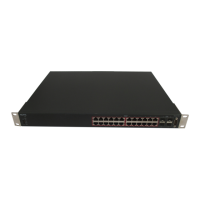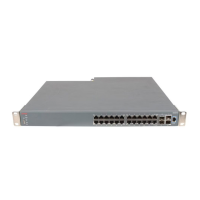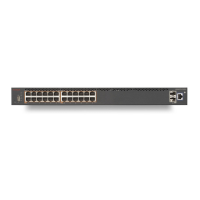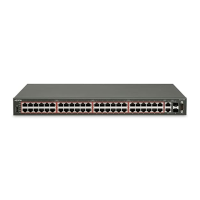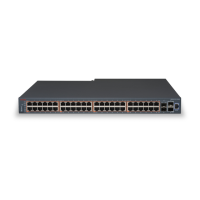Dynamic ARP inspection ensures that only valid ARP requests and responses are relayed.
The switch performs these activities:
• Intercepts all ARP request and responses on the untrusted ports.
• Verifies that each of these intercepted packets has a valid IP-to-MAC address binding
before updating the local ARP cache or before forwarding the packet to the appropriate
destination.
• Drops invalid ARP packets.
Dynamic ARP inspection determines the validity of an ARP packet based on valid IP-to-MAC
address bindings stored in a trusted database, the DHCP snooping binding database. This
database is built by DHCP snooping if DHCP snooping is enabled on the VLANs and on the
switch. If the ARP packet is received on a trusted interface, the switch forwards the packet
without checks. On untrusted interfaces, the switch forwards the packet only if it is valid.
Dynamic ARP inspection is managed on the base unit. After a new switch joins the stack, the
switch receives the Dynamic ARP inspection configuration from the base unit. After a member
leaves the stack, all DHCP address bindings associated with the switch are removed.
After a stack merge occurs, all DHCP bindings in the base unit are lost if it is no longer the
base unit. With a stack partition, the existing base unit is unchanged, and the bindings
belonging to the partitioned switches age out. The new base unit of the partitioned stack begins
processing the new incoming DHCP packets
The following ACLI commands are used for Dynamic ARP Inspection:
• The show ip arp inspection command displays the Dynamic ARP Inspection
status.
• The ip arp inspection vlan <VLANID | VLANID range> command enables
Dynamic ARP Inspection on the specified VLAN or VLANS.
• The no ip arp inspection vlan <VLANID | VLANID range> command
disables Dynamic ARP inspection for the specified VLAN or VLANS.
MAC Flush
The Avaya Ethernet Routing Switch 4000 Series Release 5.3 supports MAC Flush. MAC Flush
is a direct way to flush out MAC addresses from the MAC table. If the Layer 2 Forwarding
Database (FDB) appears corrupted, you can:
• reboot the switch or stack to conduct troubleshooting
• use the MAC Flush command to delete entries in the Layer 2 Forwarding Database
- individually
- per port
Troubleshooting tools
38 Troubleshooting Avaya ERS 4000 Series April 2014
Comments? infodev@avaya.com

